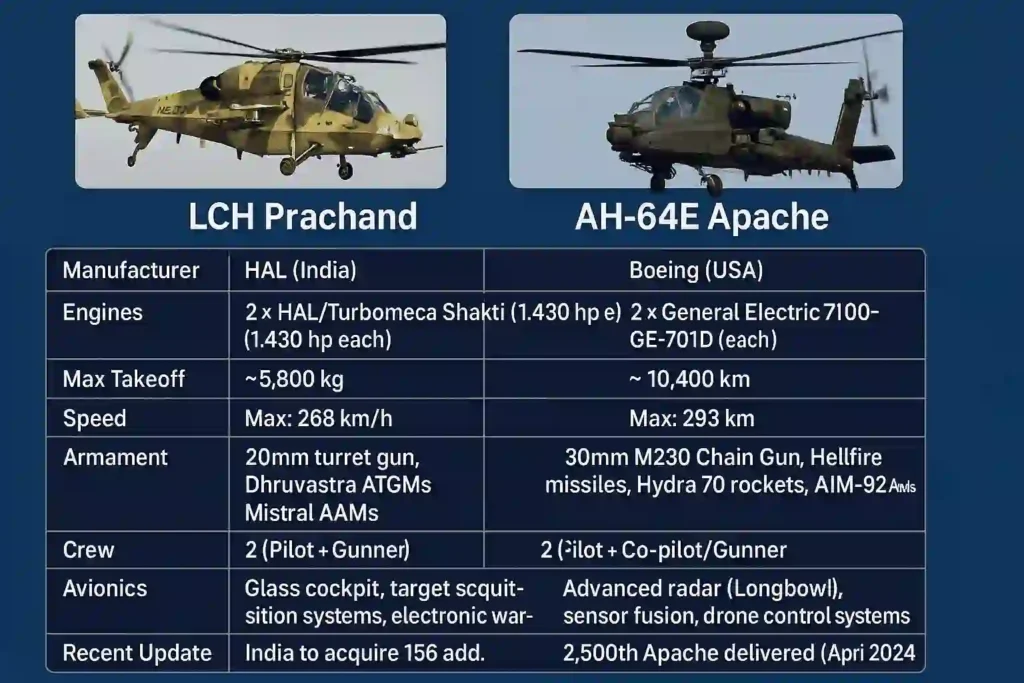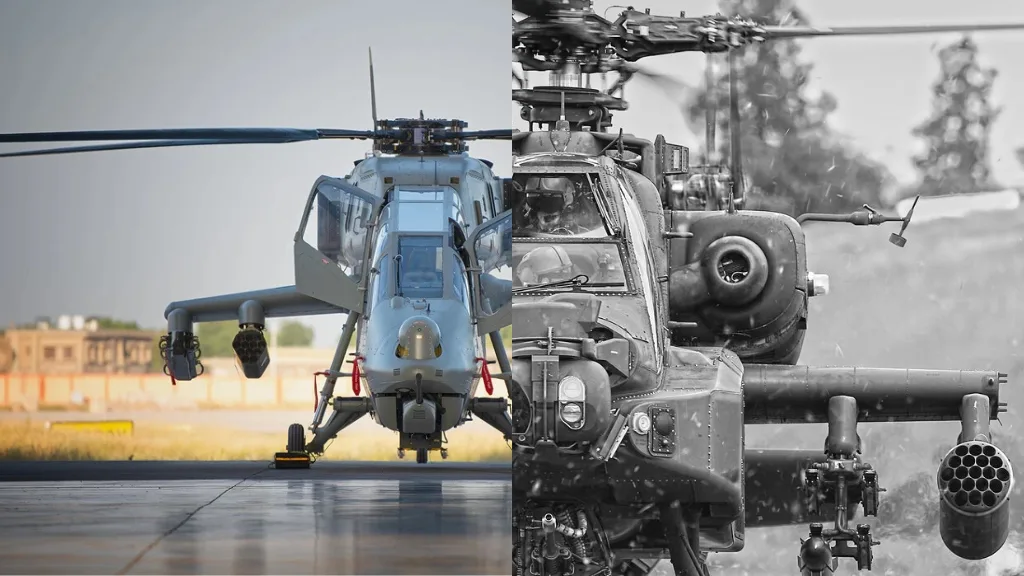LCH Prachand vs Apache—two elite attack helicopters that dominate conversations about advanced combat aviation. Built to thrive in hostile environments and execute complex, high-risk missions, these helicopters represent the peak of aerial warfare technology.
But how do HAL’s indigenous marvel, the LCH Prachand, and Boeing’s globally renowned AH-64 Apache truly compare when put head-to-head?
In this detailed analysis, you’ll explore their performance, weaponry, agility, survivability, and strategic roles on the modern battlefield. By the end of this post, you’ll clearly understand how the LCH Prachand stands against the Apache—and why each helicopter holds a crucial role in shaping aerial combat.
Dive in to discover the full breakdown of LCH Prachand vs Apache, and see which combat helicopter best aligns with strategic requirements and battlefield realities.
LCH Prachand vs Apache: Design and Performance

The LCH Prachand, built by Hindustan Aeronautics Limited (HAL), stands as India’s indigenous masterpiece in lightweight, multi-role combat helicopters. Designed explicitly for high-altitude warfare, the Prachand helicopter thrives in challenging Himalayan terrains like Ladakh and the formidable Siachen Glacier.
Its streamlined, aerodynamic frame ensures unmatched agility, providing precise manoeuvrability at altitudes where other helicopters struggle. Equipped with advanced avionics and lightweight composite materials, the LCH Prachand helicopter effectively balances endurance, agility, and combat capability, particularly suited for reconnaissance, close-air support, and surgical strikes in mountainous regions.
Key strengths include:
- High-altitude operation capability
- Exceptional agility and responsiveness
- Efficient use of advanced lightweight materials
Apache: The Heavily Armed Veteran
The AH-64E Apache, produced by aviation giant Boeing, is renowned worldwide as a heavily armoured and battle-tested attack helicopter. It has proven its combat efThe LCH Prachand Helicopter– India’s 1st Indigenous Attack Helicopterfectiveness across diverse environments—from scorching deserts to densely forested battlefields.
The Apache helicopter excels in anti-armour roles, utilising its sophisticated targeting systems, advanced avionics, and robust armour protection. With extensive use by military forces across over a dozen countries, the Apache is synonymous with tactical versatility, operational resilience, and unmatched battlefield performance, especially in low-altitude and frontline operations.
Key strengths include:
- Heavy firepower and advanced weaponry
- Robust armour for enhanced survivability
- Versatile performance in diverse terrains and weather conditions
Comparing Performance: Prachand Helicopter vs Apache
When directly comparing the two platforms, the differences become clear. The LCH Prachand helicopter, despite its smaller frame, stands out in terms of agility, altitude capabilities, and precise manoeuvring, making it ideal for mountain warfare and quick-response operations.
On the contrary, the AH-64 Apache helicopter dominates in terms of sheer firepower, superior combat range, and armour protection, excelling in sustained operations, heavy assaults, and frontline engagements.
Ultimately, the choice between LCH Prachand vs Apache helicopter depends heavily on mission-specific needs—whether agility and precision in high-altitude scenarios or overwhelming firepower and versatility in diverse battlefield environments. Continue reading to explore their weaponry, capabilities, and the strategic implications of deploying these powerful attack helicopters.
Technical Specification Comparison of HAL LCH VS AH-64 Apache

| Specification | LCH Prachand | AH-64E Apache |
|---|---|---|
| Manufacturer | HAL (India) | Boeing (USA) |
| Engines | 2 × HAL/Turbomeca Shakti (1,430 hp each) | 2 × General Electric T700-GE-701D (1,994 hp each) |
| Max Takeoff Weight | ~5,800 kg | ~10,400 kg |
| Speed | Max: 268 km/h | Max: 293 km/h |
| Range | 550 km | 476 km |
| Service Ceiling | 6,500 meters | 6,400 meters |
| Armament | 20mm turret gun, Dhruvastra ATGMs, Mistral AAMs | 30mm M230 Chain Gun, Hellfire missiles, Hydra 70 rockets, AIM-92 AAMs |
| Crew | 2 (Pilot + Gunner) | 2 (Pilot + Co-pilot/Gunner) |
| Avionics | Glass cockpit, target acquisition systems, electronic warfare suite | Advanced radar (Longbow), sensor fusion, drone control systems |
| Recent Update | India to acquire 156 additional units (March 2025) | 2,500th Apache delivered globally (April 2024) |
LCH Prachand vs Apache: Weaponry and Armament
LCH Prachand: Agile Precision Striker
The LCH Prachand helicopter excels in precision engagement with a balanced arsenal tailored for agility and accuracy. Its key weapons include a 20mm turret gun, the advanced indigenous Dhruvastra anti-tank guided missiles (ATGMs), and Mistral air-to-air missiles (AAMs). This carefully chosen weapon set ensures the Prachand can execute both air-to-ground attacks and defend against aerial threats effectively. Built for high-altitude warfare, its lightweight construction boosts manoeuvrability, crucial for missions in mountainous or restricted terrain.
Key armaments:
- 20mm turret gun for rapid close-range engagements.
- Indigenous Dhruvastra ATGMs for precise anti-armour capability.
- Mistral missiles for effective aerial self-defence.
AH-64 Apache: Dominating Heavy Firepower
In contrast, the AH-64 Apache helicopter is designed around overwhelming firepower and versatility. Its potent arsenal includes the formidable 30mm M230 chain gun, AGM-114 Hellfire missiles, and Hydra 70 rockets, enabling it to deliver devastating payloads in high-intensity combat scenarios. With its advanced target acquisition radar (Longbow radar) and sophisticated avionics, the Apache can simultaneously engage multiple targets, significantly enhancing its battlefield dominance in large-scale operations.
Key armaments:
- 30mm M230 chain gun for heavy close-combat support.
- Hellfire missiles are ideal for anti-armour and precision strikes.
- Hydra 70 rockets for versatile, area-suppression roles.
Comparing LCH Prachand vs Apache Armament Strategy
The comparison between LCH Prachand vs Apache reveals distinct strategic philosophies. The Apache relies heavily on raw power, maximum payload, and superior combat endurance, making it ideal for aggressive frontline operations and sustained firepower deployment. Meanwhile, the LCH Prachand emphasises agility, tactical precision, and operational flexibility, making it uniquely suited to precise strikes, mountainous engagements, and swift manoeuvres.
Operational Deployment
The LCH Prachand helicopter has become integral to India’s strategic defence posture, particularly along sensitive, high-altitude frontiers such as Ladakh and the Eastern Command regions. Actively deployed in mountainous and challenging terrain, it excels in roles including counter-insurgency operations, border reconnaissance, and close air support. Its lightweight construction and agile design allow it to navigate areas traditionally inaccessible to heavier combat helicopters, greatly enhancing India’s border security and rapid-response capabilities.
Operational Highlights:
- Active deployment in Ladakh and India’s Eastern Command regions.
- Crucial role in counter-insurgency and high-altitude warfare scenarios.
- Enhanced operational efficiency in terrains inaccessible to other helicopters.
AH-64 Apache: Proven Dominance in Global Combat Zones
The Apache helicopter, renowned globally for its battlefield effectiveness, has seen extensive deployment with U.S. and allied forces in diverse operational theatres, including Iraq and Afghanistan. Its sophisticated radar-guided targeting systems (Longbow radar), heavy armour, and robust survivability make the Apache a preferred asset for complex missions worldwide. Trusted by multiple international forces, it consistently proves invaluable in anti-armour operations, frontline assaults, and suppression of enemy defences.
Operational Highlights:
- Extensive combat experience in Iraq, Afghanistan, and other global theatres.
- Superior radar-guided targeting and multi-target engagement capability.
- High survivability rate, ideal for hostile environments and frontline operations.
Strategic Operational Comparison: LCH Prachand vs Apache
The comparison between LCH Prachand vs Apache helicopter highlights distinct operational strengths aligned with their intended combat roles. While the Apache boasts extensive global combat experience, superior targeting technology, and unmatched resilience in intensive frontline operations, the LCH Prachand offers unparalleled agility, altitude capability, and strategic advantage in geographically challenging border terrains.
Understanding these operational differences helps military strategists deploy each helicopter effectively, leveraging their unique strengths to maximise battlefield efficiency.
Cost and Maintenance
LCH Prachand: Indigenous Advantage & Cost Efficiency
The LCH Prachand helicopter, being indigenously designed and built by Hindustan Aeronautics Limited (HAL), provides India with substantial cost-effectiveness in terms of both procurement and ongoing maintenance. Tailored specifically to Indian operational environments and conditions, its robust, locally developed maintenance ecosystem significantly reduces long-term operational costs, boosts logistical efficiency, and ensures greater availability and sustainability of the fleet.
Key cost advantages:
- Lower acquisition and lifecycle maintenance costs due to indigenous manufacturing.
- Tailored support infrastructure aligned with Indian operational conditions.
- Greater affordability and sustainability for long-term strategic deployment.
AH-64 Apache: Advanced Capabilities at Premium Costs
The Apache helicopter, renowned for its exceptional combat capabilities, comes with correspondingly high acquisition and maintenance expenses. Built by Boeing, the Apache’s advanced avionics, radar systems, and heavy weaponry contribute significantly to its superior battlefield performance, but at a substantial financial investment. For countries with budget constraints or limited defence expenditure, the Apache’s premium price and maintenance demands may restrict operational deployment despite its unmatched performance in various combat roles.
Key cost considerations:
- High initial acquisition and ongoing maintenance costs.
- Expensive support infrastructure for advanced avionics and radar systems.
- Potential limitations on procurement for budget-conscious defence forces.
Recent Developments: Expanding Capabilities and Global Presence
- LCH Prachand Helicopter Update (March 2025):
- The Indian government approved the procurement of 156 new LCH Prachand helicopters, significantly bolstering operational deployment across the Indian Army and Air Force.
- Apache Helicopter Milestone (April 2024):
- Boeing delivered its 2,500th AH-64 Apache, underscoring sustained global demand and long-term combat reliability.
- Morocco’s Apache Acquisition (Early 2025):
- Morocco’s recent acquisition of Apache helicopters highlights the aircraft’s growing strategic influence in Africa, expanding its global operational footprint.
- Drone Swarm Integration in Apache AH-64E:
- Enhanced drone control systems integrated into Apache helicopters now support drone swarm operations, dramatically increasing their surveillance and tactical strike capabilities.
Conclusion: Which One Wins?
In the debate of LCH Prachand vs Apache helicopter, there is no universal winner—only strategic alignment with mission needs and operational contexts.
The HAL LCH Prachand helicopter represents India’s targeted solution for challenging high-altitude warfare. It combines indigenous innovation, cost-effectiveness, precise manoeuvrability, and tailored battlefield versatility, making it particularly suited to India’s mountainous borders and tactical operational demands.
Conversely, the AH-64 Apache helicopter remains the globally recognised benchmark for attack helicopters, acclaimed for its advanced avionics, superior firepower, extensive combat experience, and unmatched versatility across diverse operational environments.
Ultimately, the choice between these two elite helicopters depends entirely on strategic priorities—whether precision operations and high-altitude adaptability or sheer power and international battlefield experience.
For India’s unique defence requirements and operational realities, the LCH Prachand helicopter undoubtedly emerges as a transformative asset, effectively reshaping India’s aerial combat strategy.
